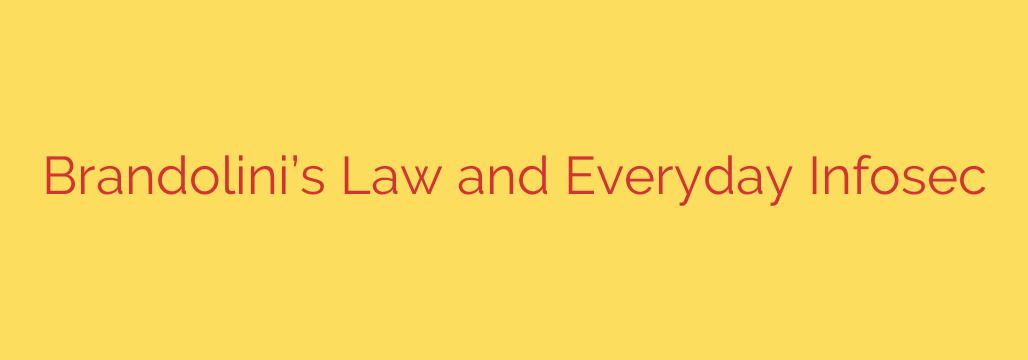
The Asymmetry of Deception: Why Debunking Digital Lies Is So Hard
Have you ever received an email or text message that looked incredibly real but set off a tiny alarm bell in your head? Maybe it was a shipping notification for an order you don’t remember placing or a security alert from your bank that seemed slightly off. The effort it took for a scammer to create that message was minimal. The effort it takes for you—or your IT department—to prove it’s fake can be enormous.
This imbalance is at the heart of a fundamental challenge in cybersecurity, and it’s explained by a concept known as Brandolini’s Law, or the “bullshit asymmetry principle.” It states that the amount of energy needed to refute false information is an order of magnitude bigger than what’s needed to produce it.
Understanding this principle is key to protecting yourself in an age of rampant digital misinformation.
The High Cost of Proving a Negative
Think about the classic phishing email. A cybercriminal can use a simple template, blast it out to millions of people at virtually no cost, and only needs one person to click the link.
Now, consider the journey of that one email when it lands in a corporate environment. An employee receives it, feels uneasy, and forwards it to the security team with a simple question: “Is this real?”
The security team can’t just say “no.” They have to prove it. This involves:
- Analyzing email headers to trace the message’s true origin.
- Inspecting the link in a secure environment (a sandbox) to see where it leads and what malicious code it might try to execute.
- Checking the domain registration of the sender and the links within.
- Cross-referencing the content against known phishing campaigns.
This entire process can take a skilled analyst significant time and resources. All of that effort is expended just to debunk a lie that took a criminal seconds to create and send. The scammer has created a huge workload for the defender at almost zero cost to themselves. This is the asymmetry in action—low cost for the attacker, high cost for the defender.
The Human Factor: Why We’re Prone to Believe
This problem isn’t just technical; it’s deeply psychological. Scammers are experts at exploiting human nature. They design their messages to trigger powerful emotions:
- Urgency: “Your account will be suspended in 24 hours!”
- Fear: “Suspicious login detected from another country.”
- Authority: Using the logos and language of trusted institutions like your bank, a government agency, or your own company.
Even when a security expert refutes the claim, doubt can linger. The email looked so professional. The warning felt so real. This cognitive dissonance makes it difficult to accept that you were the target of a simple, low-effort scam. Scammers know that our instinct is often to believe first and question later, especially when we’re busy or stressed.
Your Actionable Defense Plan: How to Restore the Balance
While we can’t stop criminals from producing misinformation, we can change how we react to it. Tipping the scales back in your favor requires a shift in mindset and a few deliberate security habits.
1. Adopt a “Trust but Verify” Mindset.
Treat every unsolicited message with healthy skepticism. Instead of trusting the content of an email or text, independently verify its claims. If you get an alert from your bank, don’t click the link provided. Instead, close the message, open a new browser window, and navigate to the bank’s official website yourself to log in.
2. Never Use Contact Information from the Message.
Scammers will provide fake phone numbers and links to fraudulent support sites. If you need to contact a company about a message you received, find their official contact information from their legitimate website or a past bill. Verification must happen through a separate, trusted channel.
3. Use Official Reporting Tools.
If your email client or company has a “Report Phishing” button, use it. Forwarding the email to the IT helpdesk is helpful, but the dedicated reporting button often includes crucial metadata (like the email headers) that helps security teams analyze the threat more quickly and efficiently. This helps them block similar attacks for everyone.
4. Pause Before You Act.
The single most effective defense against phishing is to take a deep breath and pause. Cybercriminals rely on your immediate, emotional reaction. By waiting just a few moments, you give your logical brain time to catch up and spot the red flags you might otherwise miss in a rush.
Ultimately, recognizing the asymmetry of digital deception is the first step toward defeating it. The next time a suspicious message arrives, remember the disproportionate effort required to debunk a lie. Protect your own time, energy, and security by treating it as guilty until proven innocent.
Source: https://www.helpnetsecurity.com/2025/08/11/brandolinis-law-cybersecurity-reality/








